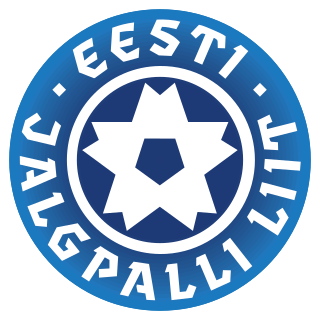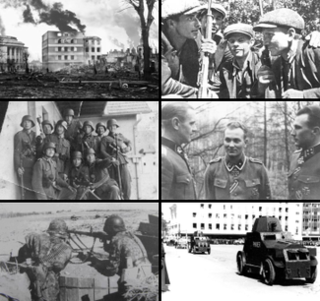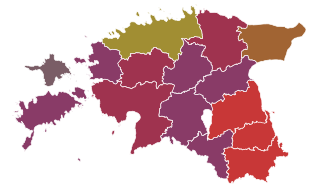Vardja | |
|---|---|
 | |
| Coordinates: 59°10′17″N25°12′38″E / 59.17139°N 25.21056°E Coordinates: 59°10′17″N25°12′38″E / 59.17139°N 25.21056°E | |
| Country | |
| County | |
| Municipality | |
Vardja is a village in Kose Parish, Harju County in northern Estonia. [1]
Vardja | |
|---|---|
 | |
| Coordinates: 59°10′17″N25°12′38″E / 59.17139°N 25.21056°E Coordinates: 59°10′17″N25°12′38″E / 59.17139°N 25.21056°E | |
| Country | |
| County | |
| Municipality | |
Vardja is a village in Kose Parish, Harju County in northern Estonia. [1]
Estonian is a Finnic language, written in the Latin script. It is the official language of Estonia and one of the official languages of the European Union, spoken natively by about 1.1 million people; 922,000 people in Estonia and 160,000 outside Estonia.

Tallinn is the most populous, primate, and capital city of Estonia. Situated on a bay in north Estonia, on the shore of the Gulf of Finland of the Baltic Sea, Tallinn has a population of 444,532 and administratively lies in the Harju maakond (county). Tallinn is the main financial, industrial and cultural centre of Estonia. It is located 187 kilometres (116 mi) northwest of the country's second largest city Tartu, however only 80 kilometres (50 mi) south of Helsinki, Finland, 320 kilometres (200 mi) west of Saint Petersburg, Russia, 300 kilometres (190 mi) north of Riga, Latvia, and 380 kilometres (240 mi) east of Stockholm, Sweden. From the 13th century until the first half of the 20th century Tallinn was known in most of the world by variants of its other historical name Reval.

Tartu is the second-largest city in Estonia, after the political and financial capital, Tallinn. It is 186 kilometres southeast of Tallinn and 245 kilometres northeast of Riga, the capital of Latvia. Tartu lies on the Emajõgi river, which connects the two largest lakes in Estonia, Lake Võrtsjärv and Lake Peipus. The city is served by Tartu Airport.

Baltic Germans are ethnic German inhabitants of the eastern shores of the Baltic Sea, in what today are Estonia and Latvia. Since their resettlement in 1939, Baltic Germans have markedly declined as a geographically determined ethnic group. It is estimated that several thousand still reside in Latvia and Estonia.

The Baltic states or the Baltic countries, also known as the Baltic nations, and less often as the "Baltic republics", the "Baltic lands", or simply the Baltics, is a modern unofficial geopolitical term, typically used to group three sovereign states on the eastern coast of the Baltic Sea: Estonia, Latvia, and Lithuania. The term is not used in the context of cultural areas, national identity, or language, because while the majority of people in Latvia and Lithuania are Baltic people, the majority in Estonia are Finnic. The three governments engage in intergovernmental and parliamentary cooperation. There is frequent cooperation in foreign and security policy, defence, energy, and transportation.

Narva is a municipality and city in Estonia. It is located in Ida-Viru County, at the eastern extreme point of Estonia, at the Russian border, on the Narva River which drains Lake Peipus. The city of Narva is the country's third largest after Tallinn and Tartu.

Pärnu is the fourth largest city in Estonia. Situated in southwest Estonia, Pärnu is located 128 kilometres (80 mi) south of the Estonian capital, Tallinn, and 176 kilometres (109 mi) west of Estonia's second largest city, Tartu. The city sits off the coast of Pärnu Bay, an inlet of the Gulf of Riga, which is a part of the Baltic Sea. In the city, the Pärnu River drains into the Gulf of Riga.

Counties are the first-level administrative subdivisions of Estonia. Estonian territory is composed of 15 counties, including 13 on the mainland and 2 on islands. The government of each county is led by a maavanem (governor) who represents the national government at the regional level. Governors are appointed by the national government for a term of five years.

Estonians are a Finnic ethnic group native to Estonia who speak the Estonian language and share a common culture and history.

The occupation of the Baltic states involved the June 1940 invasion of the Red Army, and the subsequent military occupation of Estonia, Latvia and Lithuania by the Soviet Union, under the leadership of Stalin and auspices of the August 1939 Nazi-Soviet Pact that had been signed immediately before the outbreak of World War II. The three countries were then annexed into the Soviet Union as constituent "republics" in August 1940, though United States and most other Western countries never recognised this incorporation, considering it illegal. On 22 June 1941, Nazi Germany attacked the Soviet Union and within weeks occupied the Baltic territories. In July 1941, the Third Reich incorporated the Baltic territory into its Reichskommissariat Ostland. As a result of the Red Army's Baltic Offensive of 1944, the Soviet Union recaptured most of the Baltic states and trapped the remaining German forces in the Courland pocket until their formal surrender in May 1945.

MS Estonia was a cruiseferry built in 1980 at the West German shipyard Meyer Werft in Papenburg. In 1993, she was sold to Nordström & Thulin for use on Estline's Tallinn–Stockholm route. The ship's sinking on 28 September 1994, in the Baltic Sea between Sweden, Åland, Finland and Estonia, was one of the worst maritime disasters of the 20th century, claiming 852 lives.

The Estonian War of Independence, also known as the Estonian Liberation War, was a defensive campaign of the Estonian Army and its allies, most notably the United Kingdom, against the Bolshevik westward offensive of 1918–1919 and the 1919 aggression of the Baltische Landeswehr. The campaign was the struggle of the newly established democratic nation of Estonia for independence in the aftermath of World War I. It resulted in a victory for Estonia and was concluded in the 1920 Treaty of Tartu.

The Estonia national football team represents Estonia in international football matches and is controlled by the Estonian Football Association, the governing body for football in Estonia. Estonia's home ground is Lilleküla Stadium in Tallinn.

The Estonian Football Association is the governing body of football, beach soccer and futsal in Estonia, established on 14 December 1921. It organizes the football league, including the championship which is called Meistriliiga, Estonian Cup and the Estonian national football team. It is based in Tallinn. EJL became a member of FIFA in 1923, but following Estonia's annexation by the Soviet Union it was disbanded. It became a member again in 1992 after Estonia reinstated its independence.

Populated places in Estonia, are cities or settlement units of rural municipalities, but only cities have administrative functions. Settlement units are divided into settlements and urban regions.

Before the outbreak of the Second World War, Germany and the Soviet Union signed the German-Soviet Nonaggression Pact, concerning the partition and disposition of sovereign states, including Estonia, and in particular its Secret Additional Protocol of August 1939.

The Estonian Soviet Socialist Republic was an ethnically based administrative subdivision of the former Soviet Union covering the territory of Estonia from 1940 until 1991. The Estonian SSR was nominally established to replace the until then independent Republic of Estonia on 21 July 1940, a month after the 16–17 June 1940 Soviet military invasion and occupation of the country during World War II. After the installation of a Stalinist government which, backed by the occupying Soviet Red Army, declared Estonia a Soviet constituency, the Estonian SSR was subsequently incorporated into the Soviet Union as a "union republic" on 6 August 1940. Estonia was occupied by Nazi Germany in 1941 and administered as a part of Reichskommissariat Ostland until it was reconquered by the USSR in 1944.

Estonia, officially the Republic of Estonia, is a country in northern Europe. It is bordered to the north by the Gulf of Finland across from Finland, to the west by the Baltic Sea across from Sweden, to the south by Latvia, and to the east by Lake Peipus and Russia. The territory of Estonia consists of the mainland, the larger islands of Saaremaa and Hiiumaa, and over 2,200 other islands and islets on the eastern coast of the Baltic Sea, covering a total area of 45,339 km2 (17,505 sq mi). The capital city Tallinn and Tartu are the two largest urban areas of the country. The Estonian language is the autochthonous and the official language of Estonia; it is the first language of the majority of its people, as well as the world's second most spoken Finnic language.

The COVID-19 pandemic in Estonia is part of the ongoing worldwide pandemic of coronavirus disease 2019 caused by severe acute respiratory syndrome coronavirus 2.
A list of films produced in Estonia ordered by year of release. For an alphabetical list of Estonian films, see Category:Estonian films